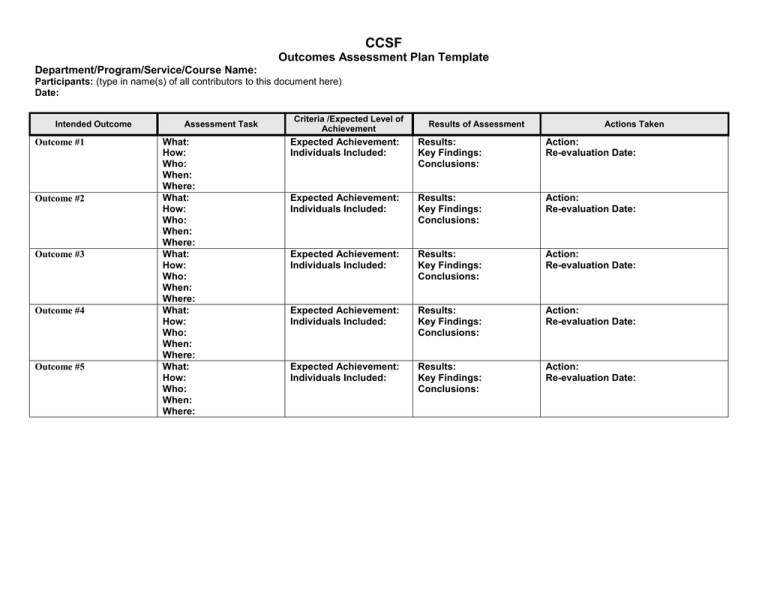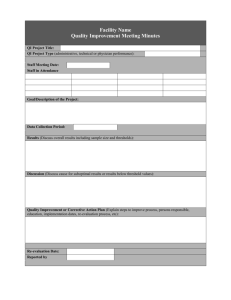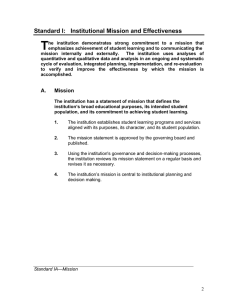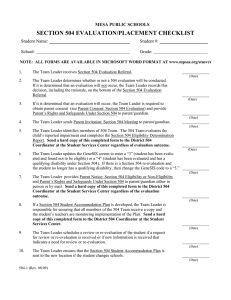CCSF Outcomes Assessment Plan
advertisement

CCSF Outcomes Assessment Plan Template Department/Program/Service/Course Name: Participants: (type in name(s) of all contributors to this document here) Date: Intended Outcome Outcome #1 Outcome #2 Outcome #3 Outcome #4 Outcome #5 Assessment Task What: How: Who: When: Where: What: How: Who: When: Where: What: How: Who: When: Where: What: How: Who: When: Where: What: How: Who: When: Where: Criteria /Expected Level of Achievement Results of Assessment Actions Taken Expected Achievement: Individuals Included: Results: Key Findings: Conclusions: Action: Re-evaluation Date: Expected Achievement: Individuals Included: Results: Key Findings: Conclusions: Action: Re-evaluation Date: Expected Achievement: Individuals Included: Results: Key Findings: Conclusions: Action: Re-evaluation Date: Expected Achievement: Individuals Included: Results: Key Findings: Conclusions: Action: Re-evaluation Date: Expected Achievement: Individuals Included: Results: Key Findings: Conclusions: Action: Re-evaluation Date: Implementing the Outcomes Assessment Process requires a plan that explains what will be measured, how it will be measured, when assessment will occur, who is responsible for assessment activities, and how the assessment information will be used. Having a written plan in place helps keep everyone on the same page, ensures that the program can be continued if a key individual leaves, and documents the nature of the assessment program for outside agencies (licensing boards, state or federal agencies, and accrediting organizations). The following outline provides the key components of a program's outcomes assessment plan. The process is intentionally shown as circulatory, in order to evoke the idea of continual improvement. 1. Identify the outcomes: Obtain consensus about the essential outcomes (varies from instructional to services) for a course/program/unit. Share these outcomes with stakeholders. 2. Determine a common assessment: Obtain consensus about the assessment tool or task - what, who, when, where, and how. 3. Establish the expected level of achievement: Calculate the anticipated success for this assessment. This should be based on previous assessment data if it exists. 4. Analyze the data: Collect and record aggregated data from the assessment. Constituency groups will analyze and evaluate this information to ascertain what is going well and what could be improved upon based on the outcome noted. 5. Actions Taken: This means using the results of an outcome's assessment project to improve whatever it was that was being assessed. Thus it is vital that the discipline/program use this data to celebrate and build on its strengths and to remediate its weaknesses. Assessment plans and results should be developed and maintained for each department/program in the college. Summaries of these plans and results will be entered online at the start of each semester for all units through an online submission form. This template is meant as a guide to help with your record keeping. You can use it to facilitate conversations inside and outside your department and periodically upload it to your website. Final note: Outcomes are developed and assessments take place for the following areas: Student Learning Outcomes (for courses, counseling, trainings, library services, etc.) Student Service Unit Outcomes (for additional services provided to students, such as transcript procurement, registration, and financial aid) Admininstrative Unit Outcomes (for services provided to faculty, staff, vendors, external organizations, etc. to produce an environment of learning for our students) This template and set of guidelines is modified from that used by Long Beach Community College.




